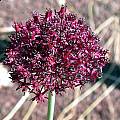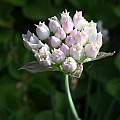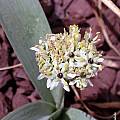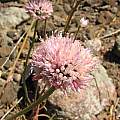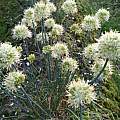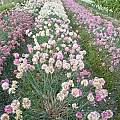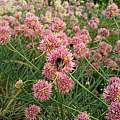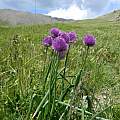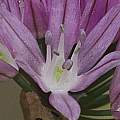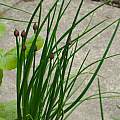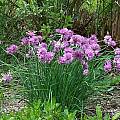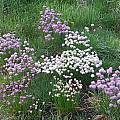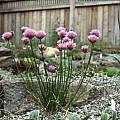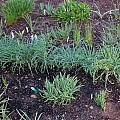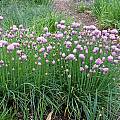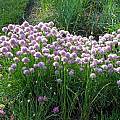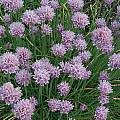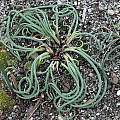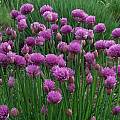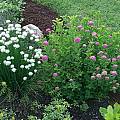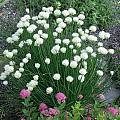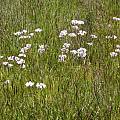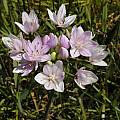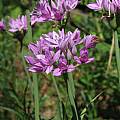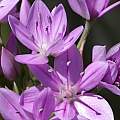This page compiles all the information and photos of the Allium taxa, cultivars, and hybrids we currently have on the PBS wiki. The Allium index gives information about the genus and includes tables of species and hybrids and cultivars.
Allium 'Globemaster' is a fantastic cross (Allium macleanii x cristophii) made by Jan Bijl, requiring nearly 20 years to bring it into commercially scaled production. It has dense globes of purple starry flowers that have that same metallic sheen evidenced by Allium cristophii (often misspelled "christophii"). The floral globes start out 4-5" across, but since the new buds pop out just beyond the spent blooms, the great spheres of bloom grow in size over several weeks. Under good conditions, the bloom heads can exceed 11" (28 cm) across! One of the best features of the "big ball" type of alliums are the fantastic seed heads. In the second photo taken 3/6/03 there are two dried 'Globemaster' seed heads. The dried seed structures are about 8 years old now, but still hold their decorative appeal. Photographed up against a brick wall, and knowing that a brick is 8" (20 cm) wide, you'll get a good idea just how huge the bloom heads can get. Photos by Mark McDonough.
Allium 'Lucy Ball' is another cross from the same parentage as 'Gladiator', namely between A. hollandicum (syn. A. aflatunense of Hort.) x macleanii (probably). The cultivar seems prone to rot in my garden, and I haven't bothered replacing it recently. The first photo shows the tight buds, and the second photo shows an inflorescence at full anthesis. Photos by Mark McDonough.
Allium 'Millenium' is a plant that I named in the year 2000, a really nice clumping plant, with a large number of sturdy stems and bright rose flower globes appearing in August. Photos by Mark McDonough and Jay Yourch.
Allium abramsii (Ownbey & Aase ex Traub) McNeal is a California species found in the higher foothills of the central Sierra Nevada. It has rose-purple flowers. Height range: 10-20 cm. Photos by Mary Sue Ittner
Allium acuminatum Hook. is native to the Western United States and Canada. It has bright rose to purple urn like flowers in open umbels and blooms May to July. It has sharply pointed tepals, the outer recurved and the inner with enrolled margins and is sometimes known as the Tapertip Onion. Another common name is Hooker's Onion. Height range: 15-30 cm. Photos 1-3 by Mary Sue Ittner. The last photo was taken by Richard Haard.
Allium acutiflorum Loisel. is a species of onion native to sandy and rocky places in Southern Europe and North Africa. Photos by Martin Bohnet and Wietse Mellema. Height range: 30-45 cm.
Allium albidum Fisch. ex M.Bieb. is found in Bulgaria, Romania, European Russia, on stony sunny slopes to about 2000 m. It has cylindrical to narrowly conical bulbs, clustered on a short rhizome, stems 15-30 cm high, linear leaves, 2- 4 mm wide, and white to yellowish flowers that are bowl-shaped to almost flat, 6-8 mm wide, in dense hemispherical umbels 2-3 cm across, summer. According to Plants of the World Online and World Flora Online in 2024 this species is considered to be a synonym of Allium denudatum Redouté.
Allium albidum ssp. caucasicum (Regel) Stearn is a nice compact form of this European mat-forming onion. The small white flowers in July and August are not particularly large, showy, or plentiful, but it's a pleasant enough little species that makes carpets of fine green strap-shaped foliage. It's small enough to grow in a trough, as shown in the image. Photos by Mark McDonough.
Allium albidum hybrid - The plant pictured is of one of the better seedlings resulting after several years of selecting among hybrid progeny derived from such species as Allium nutans, Allium senescens, and A. albidum, all of which freely hybridize with each other. This is one that shows a strong A. albidum influence, having smaller, tight heads of blooms, and very pale color, a sort of warm pinkish-white. With the shorter stems, even growth, and handsome clumps of shiny green strap leaves, it has great potential for further hybridizing. Photo by Mark McDonough.
Allium alexeianum Regel is found in the Pamir mountains in Central Asia (Tadzhikistan, Uzbekistan). Height range: 10-20 cm. Photograph by Rimmer de Vries.
Allium altyncolicum N.Friesen is native to Southwest Siberia. It was first published in 1987 and included in the Flora of Siberia in 2001. Height range: 30-60 cm. Photos from Mark McDonough who wrote: "For years I was puzzled by this very chive-like plant that had very un-chive-like growth habit, with striking bluish foliage that stands stiffly erect. The flowers appear later than Allium schoenoprasum, and the florets are individually larger, and with longer filaments. Without knowing of this species, it seemed like an entity somewhere between Allium schoenoprasum and Allium ledebourianum. I had dubbed it 'Blue Spear' alluding to the foliage form. I'm glad to at long last to have a name on this Siberian species. The flowers are light mauve. The last two photos show the plant in flower. The flower heads are very large and showy, appearing well after regular chives or Allium schoenoprasum is done flowering.
Allium amethystinum Tausch is a species from the Mediterranean where it grows in rocky places. It has hollow leaves that have withered by flowering time (May to July) and many purple flowers in a spherical umbel. Height range: 40-80 cm. Photos by Bob Rutemoeller and Mary Sue Ittner.
Allium ampeloprasum L. is the species known as the common leek. It is native to Europe and Asia, though it has been used by humans for centuries as a food and it is not known if its distribution was extended as a result. Photo by Wietse Mellema.
Allium ampeloprasum var. ampeloprasum is what we call Elephant garlic. It forms large thickened scales that are similar to true garlic (Allium sativum), but it is much milder in flavor. It is occasionally grown as an ornamental, reaching heights of up to five feet tall. The leaves grow through the winter and begin to die by the time the umbels, up to 4" across, are in bloom. The flowers are a dull purple, somewhat urn-shaped and constricted at the mouth. The flowers bloom for a very long time, new ones appearing through the center of the ball. Small bees, wasps, and even hummingbirds have been known to take advantage of the large inflorescences. Photos from Travis Owen. The last photo shows the seed head.
Allium amphibolum Ledeb. is a species of onion native to Altai, Tuva, Kazakhstan, Mongolia, and the Province of Xinjiang in western China. It is a drumstick Allium. It produces a clump of narrow bulbs up to 15 mm in diameter with scapes that are up to 30 cm tall. The leaves are straight and narrow (in Allium pumilum they are curved), up to 15 cm long, but rarely more than 5 mm across. Tepals are rose or lilac, with darker red midveins. Photos from iNaturalist were taken by Svetlana Nesterova in Russia and shared under a CC BY-NC license.
Allium amplectens Torr. is common in hot dry openings west of the Sierra Nevada in California and occasionally in Oregon, Washington, and southwest Canada. It is a variable species, with some plants forming small inflorescences, while others form much larger ones. Flowers range from white to pink in color. Height range: 20-50 cm. Not all forms of Allium amplectens are easy to grow. Photos 1-2 taken by Mark McDonough shows a pink form that is very easy to grow under normal garden conditions (eastern US), and produces a profusion of light pink starry blooms in May. Collections from arid regions are growable if planted in raised sand or clay beds. Photos 3-6 were taken by Nhu Nguyen of a form that needs a dry summer. Photo 3 show plants taken at the Tilden Botanic Garden. The last photo shows the texture of the bulb scale important in identification of many American alliums.
The first two photos were taken by Nhu Nguyen. The first is a habitat shot (Lake County, CA) showing this species growing near a stream bed. This form is able to grow on serpentine soil. The second shows a white form of this species which requires a dry summer dormancy. The last three photos by Mary Sue Ittner shows plants photographed in April 2005 at Pinnacles National Park and plants flowering in the Vina Plains Preserve in April 2006.
Allium amplectens 'Graceful' is an easily grown adaptable selection. Here are photos taken by Travis Owen showing plant in various stages of growth. The first photo shows the leaf bract towards the base, possibly a helpful characteristic to identifying the species.
Allium angulosum L is native to damp grasslands from Europe to Siberia. There are many forms in the wild and in cultivation. Photo by Mark McDonough who writes: "This spontaneous seedling was a rare find in my garden, being a very full-headed, clean white form of this fairly well-known European rhizomatous onion. Notice something rather unique about this plant, it has a tendency to form a 2nd tier of blooms with a secondary flower stalk that pops out and above the primary flower globe! There is only one other species known to this: Allium regelii. I do intend on naming and propagating this unique form of Allium angulosum. It flowers in June-July, on stems 16-18" tall. The shiny green strap foliage builds up into handsome clumps. In the photo, the blooms are emerging from the foliage of hardy Hibiscus hybrids."
Allium ascalonicum L., syn. Allium hierochuntinum Boiss., is the only blue flowering Allium in the eastern Mediterranean. This small, slender species grows in the deserts of Syria south to Egypt and Saudi Arabia, flowering in March. Height range: 30-60 cm. The photo was taken in northeast Jordan by Oron Peri.
Allium atropurpureum Waldst. & Kit. is found in cultivated ground and dry open spaces throughout the Balkans. The flowers are dark, dark red-purple with black ovaries. The stems are about 24-30" (60 - 75 cm) and flower in June. Mark McDonough has never succeeded in growing this from seed, so purchased bulbs gave him the jump-start he needed. Photos by Mark McDonough and Martin Bohnet.
Allium atroviolaceum Boiss. is a tall species with a 4" (10 cm+) nice drumstick head. It grows in the Eastern Mediterranean region with its western limit in Apulia which is the only occurrence in Italy. At the time of flowering, the leaves have already dried and disappeared. It is listed as vulnerable in the Regional Red List. Photo in habitat by Angelo Porcelli.
Allium backhousianum Regel is a tall (over 100 cm) onion with greenish white flowers. It grows best in a sandy well drained medium in a sunny position. Photo by Wietse Mellema.
Allium barsczeweskii Regel is a small, yet showy species, widespread in Central Asia, growing in open grassy habitats, usually solitary, occasionally forming small clumps. Blooming in June. Height range: 30-60 cm. The photos are were taken in Kazakhstan by Oron Peri.
Allium basalticum Fragman & R.M.Fritsch is a newly described species from Syria. This robust species is 40-80 cm tall, belonging to the Allium nigrum group. It grows in open fields on volcanic soils, blooming in March-April. Photos were taken in the Golan Heights, Syria, by Oron Peri
Allium beesianum W.W.Sm. is a Chinese species, and one of the few true blue flowered Allium species, growing to about 45 cm. This late summer blooming allium is often confused with Allium sikkimense. The latter flowers in July whereas A. beesianum flowers in late August to September. Arthur Kilpin Bulley (1861-1942) was a rich cotton merchant from Cheshire who founded the company Bees Seeds and employed some of the famous plant hunters and this is where the name derives from. Classification of the plant in 1914 is credited to the Scottish botanist Sir William Wright Smith (1875-1956). It is found in SW. Sichuan and NW. Yunnan. Photos by Mark McDonough, taken August 23, 2002 and one week later on Aug. 31st, with more flowers open and foliage showing:
Allium bolanderi S.Watson (syn. Allium stenanthum Drew) is a small onion growing in decayed granitic soil under native oak trees in California and Oregon. Height: about 20 cm. The bulbs are smooth, elongated, and less than 1/2" in length. Bulbs are connected to the plants by delicate white rhizomes. It requires a very dry summer with absolutely no water. Photos are taken by Nhu Nguyen. The 1st photo shows a darker form of the species. The 2nd photo shows an in situ shot in Yolo County, CA, where it was growing among poison oak.
The photos below were taken by Nhu Nguyen. The third and fourth photos are closeups of the flowers and inflorescence. They also show the powdery quality of the underside of the tepals. Photos 4-5 show the bulbs dividing from two to four bulbs. The last photo shows the bulb lying in the ground horizontally. The remnants of the rhizome can be seen on top of the bulb.
Allium bolanderi var. mirabile (L.F.Hend.) McNeal (syn. Allium mirabile L.F.Hend., Allium roguense M.Peck) is a small white flowered variety native to Southern Oregon and Northern California. It bloomed in June in Rogue River, Oregon. Photos by Travis Owen.
Allium bulgaricum (Janka) Prodan (syn. Nectaroscordum bulgaricum Janka, syn. Nectaroscordum siculum ssp. bulgaricum (Janka) Stearn) in 2025 is considered by Plants of the World Online and World Flora Online to be a synonym of Allium siculum ssp. dioscoridis (Sm.) K.Richt. Allium siculum and Allium bulgaricum are a taxonomic nightmare where some authors placed them in the same species and others separated them.
Allium caeruleum Pall. (syn. Allium azureum Ledeb.) is readily available, inexpensive, free flowering and very pretty in the garden. Its native range is from eastern Europe to China. This species, here photographed in the Maryland, USA garden of Jim McKenney in early June 2005, seems to require dry summers to persist from year to year. As the plants get older, the umbels tend to become irregular and bulbiferous. But the wonderful color does not change. The orange flower seen in one of the photographs is the perennial poppy variously known as Papaver atlanticum or P. rupifragum. The poppy and the blue onion make a cheery late spring combination. Photo 3 by M.Gastil-Buhl shows bulbs on a 1 cm grid. Photo 4 by David Pilling displays bulbils in the flower head.
Allium caesium Schrenk - a deep blue form from Antoine Hoog. This Central Asian species is variable and occurs in a number of different forms and shades of blue. Previously I have grown a soft gray-blue form, but the dark blue form shown in the first picture is also attractive, flowering in early summer. The next two photos illustrate two more forms, collected from Central Asia by Arnis Seisums, showing the variability of the species. The flower heads are large and a beautiful pale yet rich milky blue color. Both photos taken in June 2004. All photos by Mark McDonough.
Allium callimischon Link is native to Albania, Greece, and Turkey. It has two subspecies. Ssp. callimischon is found in Albania and Greece and has white unspotted flowers with a reddish-brown vein. Although the flower stalk is formed in spring, the leaves shrivel in summer and it is not until fall that flowers appear from what looks like a dead stalk. The first photo is by John Lonsdale. The second photo by Jane McGary shows it flowering in late October on the Mani Peninsula, Peloponnese, Greece. Photos three and four by Rimmer de Vries. The last of these shows ssp. callimischon in the foreground and ssp. haemostictum in the background.
Allium callimischon ssp. haemostictum Stearn is native to Crete and Turkey and has 'blood spots' on the flowers as its name suggests. Photos by Rimmer de Vries. He comments that "it is green in the cool wet season October to June and brown and dry in the hot season and blooms on the dead looking brown stalks in Fall; this habit is for both sub-species. There are other dry and cool season alliums with this habit such as Allium arlgirdense. It took 4 years to get the clump in photo 4 above to size, planted in a 5 inch x 6 inch deep clay pot plunged in sand and kept dry July to September".
Allium campanulatum S.Watson - an odd species, but one that I like nonetheless. It flowers in early spring, preferring clay soil in a raised bed, in full sun. The flowers are nearly at ground level and typically show a two-toned flower, the center of each flower being pale compared to the deeper ends of the tepals. The stems are very brittle and easily broken. The flowers are different from most other American alliums in that they open completely where the tepals lay on a flat plane. Height: 20-30 cm. They are found in California, Nevada, Oregon and Washington states. The mother bulb produces numerous offsets. First photo by Mark McDonough, second photo by Nhu Nguyen at the UC Botanical Garden. The last two photos were taken by Mary Sue Ittner including a picture of the bulbs on a 1 cm grid.
The photos below were taken in habitat by Nhu Nguyen on July 17, 2009 in the high Sierra Nevada near Sonora Pass. In this area there are two slightly different color forms. Both of these are found on sandy soil in full sun.
Allium canadense L. "red bulbil form from Texas" - Typical Allium canadense is best avoided as a weed because most of the flowers are replaced by bulbils, and aside from being ugly, the bulbils drop off and start new plants. Over the years I've kept just this one form with its white red-tipped bulbils, occasionally sputtering forth a white bloom or two. With the green sprouting tips to the bulbils, I thought the plant had a whimsical appearance and was thus appealing. Each year I would cut the stems off, then bag and discard the promiscuous propagules. Now I wish I had kept a few, because last summer a wild animal dug up and ate the clump! (there are foxes in the yard, and they've taken to digging and eating some alliums, particularly A. paniculatum). Photo by Mark McDonough.
Allium canadense forma florosum - This is a rare non-bulbilliferous form of the weedy A. canadense, the type species being weedy on account of the many bulbils that replace the flowers. The plants shown here were collected by Thad Howard in Texas, found in a couple locations growing amongst millions of the normal weedy types. This name, proposed by Thad Howard, has not yet been published, yet this is a highly ornamental form with large heads of white to barely tinged pinkish flowers, and rarely 1-3 obscure bulbils. In the second "garden view" of the same plant, you can see what a fine statement it makes in the garden, growing to about 30" (75 cm) tall, flowering in June. Photos by Mark McDonough.
Allium cardiostemon Fisch. & C.A.Mey. has black currant purple flowers in summer and is native to Iran and the Caucasus. It needs a dry summer rest. Photo by John Lonsdale.
Allium carinatum L. is from much of Europe into Asia, naturalized elsewhere (the British Isles). Informal sprays of little rose-purple, rose-pink, to white flowers dangling on very long slender pedicels, sometimes with bulbils (though many selections are bulbil-free). Height range: 30-60 cm. Illustration below showing many green bulbils from "Deutschlands Flora in Abbildungen (nur Tafeln)" (1796) Stuttgart Anzahl gescannter Seiten: 883.
Allium carinatum ssp. pulchellum (G.Don) Bonnier & Layens is a European species that is very close to Allium flavum, flowering at the same time in June or July depending on the variety grown. The second photo is of a a dwarf bluish-purple form and a creamy white form, collected on Mt. Olympus, Greece. This is the plant that was offered by Hoog & Dix as a blue-flowered form of Allium flavum ssp. tauricum, but it is undoubtedly a "pulchellum" variant. Since the photograph shows such a confusing jumble of flowers, I circled the topic species in red. Behind the blooms are the white flowers of an Achillea and pinkish A. flavum ssp. tauricum in the foreground. Finally there is a drawing of a dark pink form. Photos #1-2 and drawing #3 by Mark McDonough. Photos 4-5 were taken by Nhu Nguyen.
Allium carinatum ssp. pulchellum f. album is a white form often sold by Dutch bulb dealers. Photos below by Travis Owen of an adaptable selection. It has thrived in sun and shade, though it flowers better in the sun. The leaves are nearly evergreen in irrigated beds, dying down after new leaves have already broke the soil surface. The third photo shows a tiny bee, shorter than a pencil is wide, visiting the florets. The last photo shows the seed pods, like most Alliums the florets turn up for the seeds to ripen.
Allium carmeli is a species native to Israel, Syria and the Lebanon. The white form is typical for Mount Carmel, while in other populations consist of the pink form. Photos by Gideon Pisanty.
Allium carolinianum Redouté is not from Carolina at all, but a Himalayan species. It can be a difficult plant to please, and in most years the buds abort for some reason. The foliage is quite remarkable, being very thick and waxy, particularly when first emerging. The first photo is early in the spring; the second was taken June 2002, when at least one of the buds was spared and condescended to flower. The plant is variable. I have grown better performing forms in the past, but alas over the years the others have perished. Height range: 10-30 cm. Photos by Mark McDonough.
Allium cepa L. is the cultivated onion. Typically grown as a biennial, it is a perennial plant normally planted in the autumn for harvest the following spring or summer without being allowed to flower. They aren't the best garden plants as the large hollow stems are easily bent and will not tolerate much in the way of wind or disturbance. The dense flower heads, normally between 2" to 3" across, are attractive to bees who collect the nectar and occasionally the pollen. Height range: 30-60 cm. Allium cepa var. aggregatum G.Don, also known as the shallot (but considered a synonym), is seen in the photo below by Travis Owen.
Allium cernuum Roth, the nodding onion, hails from most states within the USA (and up to Canada) and therefore is extremely variable. Height range: 30-45 cm. The first 4 photos of a massed planting from Mark McDonough. In the first view, we see prolific blooms on a tall rose purple form of the "nodding onion" flowering in late June. In the lower left corner of the photo is Lilium formosanum var. pricei. In the second we see 4 nodding buds. It is clear why the "nodding onion" received such a common name, when one views the drooping buds. In this view the buds are just breaking through the bud spathe. The third is a similar view to the preceding, but here the flowers are open, showing nice pink rotund florets, hanging downwards. The final shot is a "good pink form" - the tall stems growing up through the invasive Campanula takesimana. The last two photos from Travis Owen are of a seed grown Allium cernuum, flowering for the first time in July of 2015.
Allium cernuum 'Leo' - one of my favorite cultivars, with tall, stiff stems to 30" (75 cm) or more, topped with clusters of white flowers (sometimes showing a tinge of pink in cool weather) that are denser than normal. Also distinctive in it's late flowering, in full bloom in mid August. The foliage is also shorter and neater than most cernuum forms... could have some A. stellatum blood in it. In the last two close-up views of the flowers the very short and tight "crook-necked" buds, the later than normal flowering period, along with the sideways disposition of the inflorescence, indicates some A. stellatum influence. Photos by Mark McDonough.
Allium cernuum 'Oxy White' (syn. A. oxyphilum) - I've tried photographing this delicate beauty for years but never really captured the essence of this fine plant. From southeastern USA, once regarded as a separate species (A. oxyphilum), most authorities now regard this as merely a form of A. cernuum , as do I. It's a most airy and delicate plant, with slender stems, and thread-thin pedicels holding little white flower droplets. In the last photo, seedlings of A. cernuum 'Oxy White' show lots of variation and a tendency back towards normal cernuum appearance. Photos by Mark McDonough.
Allium chamaemoly L. is a winter flowering species found in numerous Mediterranean areas including North Africa. Height: about 10 cm. Photo by Angelo Porcelli.
Allium commutatum Guss. - A very late flowering allium for a Mediterranean plant, in bloom from July or later. This curious species grows on rocky slopes by the ocean and at the time of flowering is totally leafless. Bulbs are salt resistant and floaters, and they are dispersed during sea storms. Plants are found also growing deeply embedded in the pebbles of the beaches, having fallen down from the slopes above. Height: to about 45 cm. Photo in habitat by Angelo Porcelli
Allium convallarioides Grossh. is a European species that's not generally in cultivation. It is a pleasing species with handsome umbels of white flowers. It is similar in appearance to Allium paniculatum L. and Allium pallens L., but in this species the slightly "ballooned" hollow leaves distinguish it from the other species. It flowers in June and July. Height: to about 60 cm. Photos by Mark McDonough.
Allium cratericola Eastw. is a lovely little onion restricted to California. It is most often observed in the wild in Table Mountain in Butte County. The inflorescence stays appressed to the ground. In California, it tends to bloom much earlier than other onions, often times forming seeds by the middle of April. It can tolerate a variety of substrates including serpentine, volcanic, and granitic sediments. The key to cultivation is that the medium must be well drained with some organic matter. It likes being in full sun. Winter water is necessary, but a dry summer dormancy is extremely important. Photos by Nhu Nguyen. Photo 1-2 were taken at the Tilden Botanic Garden.
The photos below were taken on Table Mountain in Butte County. They show various color forms and this species growing with other geophytic friends.
Allium crenulatum Wiegand or Olympic Onion is a species native to Oregon and Washington states and British Columbia. The species is variable in its Oregon range and tend to be more uniform in the more northern range. Plants flower from late May to July on talus slopes and clay soils, including serpentine. Height: to about 20 cm. Photos by Kathleen Sayce taken on Saddle Mountain in NW Oregon.
Allium crispum Greene is a species that grows in the coast ranges of California south of San Francisco in clay and serpentine soils. This is a long blooming Allium. The photos below were taken in situ by Mary Sue Ittner April 2005 in an especially wet year. Height range: 10-20 cm. Photo 1 shows a flower in bud in Pinnacles National Park and photos 2-3 are of flowers blooming along a bank on Jolon Road in Monterey County. Photo 3 shows it with a light colored Collinsia heterophylla Buist ex Graham. Photo 4 taken at Figueroa Mountain.
The photos below are of cultivated plants. Photo 1 was taken by Mary Sue Ittner in 2004 showing flowering plants she is growing. Photos 2-5 were taken by Nhu Nguyen. Photo 2 shows the crinkled edges of the petals, thus giving this species its specific ephithet, crispum.
Allium cristophii Trautv. (often misspelled as christophii) is a species with blue-purple flowers. It is native to central Turkey (Kayseri), northern Iran, and Turkmenistan. It widely cultivated. In cultivation, I put the plants into a dry summer dormancy after flowers/seeds have developed. When winter comes around, even if water is available, the bulbs will only make roots and will not emerge until spring. Flower photos by Nhu Nguyen. Height: to about 45 cm. Photo 1 shows details of the flowers. Photos 2-3 show the inflorescence(s) grown in the ground in front of a dazzling display of the iceplant Drosanthemum bicolor L.Bolus. Bulb photo by David Pilling.
Allium cyaneum Regel is a dwarf, mid to late summer flowering blue allium from China. It is extremely variable, but typically a small plant 6" or less in height, with fine grassy foliage, and small pendant to semi-erect sprays of starry blue flowers, variable in color from pale grayish blue to deep cobalt blue. Albino forms are known but rare. The first three photos from iNaturalist were taken by Leoš Smutný in China in July and shared under a CC BY-NC license. The fourth photograph was taken by Rimmer de Vries who comments: "this is typically offered as an impostor for Allium beesianum, but has super fine grass-like foliage, is shorter, blooms later and the stamens extend beyond the tepals". The last image is a drawing by Mark McDonough.
Allium cyathophorum Bureau & Franchet is a Chinese species that reportedly grows in meadows and slopes in rock crevices at elevations of 2700–4600 m. Two varieties are widely accepted: var. cyathophorum and var. farreri.
Allium cyathophorum var. cyathophorum has petals that are rounded at the apex compared with the acute or pointed petals in var. farreri, there is also a small difference in the shape of the filaments. Height: 45 cm. Grows at a higher elevation, typically around 3000-4600 m.
Allium cyathophorum var. farreri (Stearn) Stearn (syn. Allium farreri Stearn) is native to China where it grows on grassy slopes at high elevations of around 2700-3600 m. It has reddish purple flowers with stamens fused in a tube. It appreciates moist conditions in summer and tolerates shade, and grows to about 36 cm. It flowers late spring to summer. First photo by John Lonsdale. Following two photos of first year flowers by RH grown in pots in the UK, initially obtained as Allium sibthorpianum Schult.&Schult,f. from Alpine Garden Society seed. Last photo by Travis Owen shows the root mass. The roots are present year-round and should not be allowed to dry out.
Photos by David Pilling taken at the start of June 2013; this plant was grown from seed supplied as Allium sibthorpianum and sown at the start of 2009; it has been flowering for a couple of years.
Disassembling the flowers: these photographs were taken a few days later than the ones above and it is apparent the flowers are now more red. Photo 4 shows a ripe seed pod with seed visible. Photo 6 is of the roots after the plant had gone dormant at the end of the year. Flora of China says of the type species "Roots rather long, thick. Bulb solitary or clustered, cylindric; tunic grayish brown, fibrous, sometimes subreticulate." and provides an illustration.
Seeds were put in a zip-seal bag with damp kitchen towel on 14th December 2013 and exposed to outside temperatures (around 40 °F); by the middle of January 2014 they had begun to germinate as shown in photo 1. Photo 2 is of the shoots of mature plants.
Allium daninianum Brullo, Pavone & Salmeri is a species from Israel, Syria, Lebanon, Palestine and Jordan. Height range: 5-25 cm. Photo by Gideon Pisanty.
Allium darwasicum Regel is another Central Asian species. This one intrigues me with its creamy white and green-striped flowers, but I like it mostly for the incredibly sweet candy-like scent. Height: about 45 cm. Photo by Mark McDonough.
Allium decipiens Fisch. ex Schult. & Schult.f. ranges from eastern Europe to Siberia and northern Turkey. It has glossy green lorate leaves held close to the ground, and tall stems to 3' (90 cm) with lovely domed clusters of pink to lilac starry blooms. The second photo shows the pink form of Allium nigrum L. in early anthesis and a single Allium decipiens bloom just behind. The first two photos by Mark McDonough and the last three by Wietse Mellema.
Allium desertorum Forssk.is a species native to Israel. Height range: 30-60 cm. Photo by Gideon Pisanty.
Allium diabolense (Ownbey & Aase ex Traub) McNeal (syn. Allium fimbriatum var. diabolense Ownbey & Aase) is a California species found south of San Francisco Bay in the Inner South Coast ranges where it is often found growing in serpentine. It has white flowers with pink midveins and one leaf. Height: about 20 cm. Photos 1-2 were taken by Mary Sue Ittner of plants growing on Figueroa Mountain in Santa Barbara County.
The photos below were taken by Nhu Nguyen of plants in cultivation. Photos 1-2 were taken at the UC Botanical Garden.
Allium dichlamydeum E. Greene grows near the coast in Northern and central California. The inflorescence is medium pink. The Flora of North America describes the bulbs as having a herringbone pattern. See the Flora's description of Allium dichlamydeum. The herring bulb pattern is on the bulb coat and this is often partly or completely missing if the bulb is dug up. The underlying bulb is white. Therefore the zigzag/herringbone pattern may not be readily apparent and in any case is more easily visible with a hand lens. Height range: 10-30 cm. Photo of bulbs by Ken Gilliland.
Since they grow on cliff faces where there is little soil, their bulbs do not bury very deep. It is one of the latest blooming of the Californian onions. These pictures by Bob Rutemoeller show it growing on the Mendocino Sonoma Coast in bud on a coastal bluff, in bloom in the same spot a few weeks later, and a close-up. The fourth picture shows it growing in a wild rock garden where it would be difficult for predators to get it, and almost two months after the first pictures in mid July 2003 it is still in bloom, now with Dudleya farinosa (Lindl.) Britton & Rose blooming at the same time. The final picture is a close-up of the two plants in bloom in another year.
Photo 1 below shows the plants growing in a raised bed in Mary Sue Ittner's garden. Photos 2-3 by Mark McDonough show two views of this species growing in his Massachusetts garden. Photos 4-6 were taken by Nhu Nguyen of plants growing in a small pot in California. The bulbs divide well and produces a wonderful show.
Photos below by RH. Photos three and four originally obtained as Allium falcifolium Hook & Arn. Photo four shows flowers going over and becoming pointier as they wilt, this had created some confusion for the grower.
Allium dictyoprasum C.A.Mey. ex Kunth is a tall, small flowered species from Israel. Height: 60 cm. Photos by Gideon Pisanty.
Allium douglasii Hook. is native to Washington and northeastern Oregon. This variable species prefers vernally wet soil in shallow depressions or moist slopes. Height range: to about 25 cm. Photos by Richard Haard.
Allium ericetorum Thore is a species native to mountainous areas surrounding the Mediterranean. It grows to roughly 50 cm, with a round scape. Photo by Wietse Mellema. Illustration from the Atlas der Alpenflora, 1882.
Allium eulae Corey ex T.M.Howard (synonym A. fraseri var. eulae (Ownbey) Shinners), is native to Texas where it is endemic to the Texas Highland Lake region, growing in seepy places, although hardy in more northern climates and growing well in normal well drained garden soil in full sun. Height: to about 40 cm. Photo by John Lonsdale.
Allium falcifolium Hook. & Arn., Scytheleaf Onion, occurs on serpentine soils and outcrops from San Francisco Bay to Oregon. It is often found on slopes with excellent drainage. It is also never found too far away from oak trees, relying on the organic matter from decaying oak leaves. The hummus contents can range from 50% - 20% in the wild. The reddish or yellowish green stem is flattened such that it is thick in the center and thin along the edges. There are usually two leaves which are curved like the blade of a scythe. The flattened stem is no more than 5 cm and topped with a flower cluster of 10 to 30 bright rose-purple or maroon flowers. Individual plants in a population may be pale pink or white with darker midveins. Height range: 10-25 cm. The first photo is of a specimen grown by Nhu Nguyen. The next three photos were taken by Mary Sue Ittner and the last photo by Jane McGary.
Habitat photos from Nhu Nguyen are shown below. Photos 1-2 show the habitat in Napa County where they flower with Eschscholzia caespitosa Benth. amongst the serpentine rocks. Photo 5 illustrates the sickle shaped leaves.
The photos below of a white/pink form were taken by Nhu Nguyen on Mount Diablo in Contra Costa County, CA. This form interestingly does not grow on serpentine. Photo 1 shows wonderfully curly leaves.
Allium fimbriatum S.Watson is restricted to California where it grows on dry, well-drained slopes. Height range: 10-37 cm. There are three varieties of the species accepted by the Jepson Manual and Flora of North America. A fourth, listed in Plants of the World Online, Allium fimbriatum var. denticulatum Ownbey & Aase ex Traub is considered by the Jepson Manual to be a synonym of Allium denticulatum (Traub) McNeal
Allium fimbriatum var. fimbriatum is distributed in California to Baja Mexico. It has rose purple flowers with flaring tips. It grows in gravelly volcanic or serpentine clays. The photos below were taken by Nhu Nguyen in Pinnacles National Park.
Allium fimbriatum var. mohavense Jeps. is only found in the Mohave Desert. It has flowers that are white to pink to light lavender.
Allium fimbriatum var. purdyi (Eastw.) Ownbey ex McNeal is restricted to serpentine soil in the inner North Coast ranges (Colusa, Glenn, Lake, Napa counties). Flowers are white to pale lavender with darker midveins. The first three photos were taken by Nhu Nguyen. The second photo shows developing into seeds and the third photo shows a serpentine slope where they occur.
Photos below were taken by Mary Sue Ittner. The first three were taken along Bear Valley Road in April different years. They were growing along the bank next to the road. The last shows flowers of plants grown from seed collected in Lake Co. at 2150' in crumbly, flaky serpentine talus flats.
Allium flavum L. is native to the Mediterranean. It is one of the species which has been selected for numerous color forms as seen in the entries below. Height range: to about 60 cm. The first two photos below were taken by Nhu Nguyen at the UC Botanical Garden in August 2008. The particular accession was collected from France. It grows under the shades of oak trees where it gets filtered sunlight. The next two photos from Mary Sue Ittner, including one with a pollinator.
Allium flavum ssp. tauricum (Besser ex Rchb.) K.Richt. (syn. Allium paczoskianum Tuzson) "selected mixed colors" photo taken July 8, 2002 followed by "Selected mixed colors in the morning". You have to love these things; the colors are so lovely, refreshing, and variable. Due to their pastel flower colors, and the fact the florets are waxy and have an underlying color, then covered with a dusty "bloom" or powder of another color on the outside, the color rendition is hard to characterize and each looks very different depending on light and time of day. I particularly like to observe them in the low morning light. Notice too, the wide, boat-shaped spathe valves that mix in with the flower heads, more pronounced on some specimens than others. Photos by Mark McDonough.
Named Color Forms - The following list represents a sampling of named color forms that I selected over the past several years. All photos by Mark McDonough.
The first two photos below are of 'Boston Baked Beans' and the third shows 'Cantaloupe' and 'Tan'. The fourth photo is of 'Cinnamon' - one of my favorite colors, and the first to be selected in the deep orange range. The color changes over its bloom cycle, but in general could be characterized as a burnt brownish or burnt reddish-orange. As with most "tauricums", the growth is compact and stocky, typically 8"-10" (20-25 cm) in height, clumping well, and with gray or silvered foliage, the silver patina most evident on the stems.
The first two photos show 'Drawn Butter' and 'Hot Cauldron 1'. The third photo is of 'Hot Molasses' followed by two of 'Lemon Cooler' the latter is one of the more lively colored selections I made in summer 2001 with orangy-yellow and pink flowers. There was a "Hot Cauldron 2" selected as well. I believe both were lost over winter due to rodent predation, but I did save seed. In the foreground is a dwarf, deep pink form just "going over".
Photos of 'Lindsey', 'Pastel Parasol', 'Silver Shrimp', and 'Truely Faded', the last in bud, showing the striking silver coloration of stems and spathes.
Unnamed Color Forms - The following list show yet more variation in flower color and plant form. All photos by Mark McDonough.
First mixed colors, 2 yr. old seedlings, then 3 yr old seedlings, an orange form at late anthesis, ageing to rose, and orange and pink forms from a squirrel's eye view.
Photos below illustrate orange, pastel two-toned yellow and orange form and pink, a light yet lively form with blue-white stems, a robust wiry-leafed form with bright pink flowers, tawny pastels in pale melon colors, and white-aging-pinkish, and an orange-aging-rose form.
Allium geyeri S.Watson is native to North American Pacific coast damp meadows. Named for the German botanist Charles A. Geyer who travelled across the Western USA in 1843. Height range: to about 50 cm. Photograph by Rimmer de Vries.
Allium glandulosum Link & Otto is a Mexican species that blooms in late summer and autumn with dark, metallic red flowers. Height: to about 30 cm. The plant shown here in the first three photos from Mark McDonough was originally collected in central Mexico at high elevation in swampy soil. It was difficult to photograph well. The first two show the true red flowers close up, the third an entire potted plant. The last photo by Wietse Mellema.
Allium gooddingii Ownbey - another of the moisture-loving western species, this one from Arizona and New Mexico, growing at high elevation swampy or marshy spots, or alongside streams. It's a slender plant, with a few-flowered upright spray of intense red-purple flowers. The gray stems reach about 18" (45 cm). In the photo we see the gray foliage of A. plummerae S.Watson in back and a flower head of A. flavum L. Photo by Mark McDonough.
Allium griffithianum Boiss. - a beauty from C. Asia, with upright, flat-topped drumsticks of large carnous red-rose flowers, showing conspicuous dark red stripping. Allied to A. jacquemontii Kunth., Allium griffithianum only stayed with me a couple years, then succumbed (bulb rotted, I think). Height: to about 30 cm. Photo by Mark McDonough.
Allium guttatum Steven has a wide distribution from the Ukraine to the Mediterranean. According to the Plants of the World Online there are five accepted subspecies. Height range: 30-70 cm. Photo by Wietse Mellema.
Allium guttatum ssp. dalmaticum (A.Kern. ex Janch.) Stearn is from Albania and W. Yugoslavia to E. Bulgaria, where it is considered endemic. This is a pink to purple color variant of Allium guttatum. It is nice, but not as attractive as the ssp. sardoum shown below. First photo by Mark McDonough, second by Rimmer de Vries.
Allium guttatum ssp. guttatum ranges from the Aegean region to Ukraine. It has whitish tepals blotched with purple.
Allium guttatum ssp. kartalkayaense Yild. is native to Turkey.
Allium guttatum ssp. sardoum (Moris) Stearn is a fine European species from Portugal to Turkey, with dense heads of white flowers held precisely spaced, showing off bright white pedicels and small fluffy white florets stained with a small dark blotch on each tepal. The first photo was taken by Mark McDonough, July 18, 2002 and another view of this species is shown in the second photo of plants grown by Arnold Trachtenberg in New Jersey from bulbs purchased from Pacific Rim Native Plant Nursery.
Allium guttatum ssp. tenorei (Parl.) Soldano has a range from Tunisia to Libya.
Allium haematochiton S.Watson is found both on dry slopes and ridges from the south coast ranges of California into northern Baja, but also is found in seasonally moist, grassy meadows. It is tolerant of summer water and almost evergreen in those conditions. If dormant it is one of the first to appear in the fall and long blooming. It is also known to grow on serpentine. Height range: 15-40 cm. The first two photos were taken at Figueroa Mountain April 2005 by Mary Sue Ittner. The third photo was taken by Bob Rutemoeller. The last two pictures below are of bulbs grown and photographed by Nhu Nguyen. The second photo shows the blood-red skin of the bulbs, giving it the specific epithet "haematochiton" or "red tunic" in Greek, although not all forms will have the red color.
Allium heldreichii Boiss. grows in rocky places from 700 to 2000 m (2000 to 6000 ft) in Greece and flowers in summer. Height range: 30-40 cm. Photo by Arnold Trachtenberg of a plant grown from NARGS seed from 2002.
Allium hermoneum (Kollmann & Shmida) Brullo, Guglielmo, Pavone & Salmeri is a species native to Israel. Height range: 25-50 cm. Photo by Gideon Pisanty.
Allium hickmanii Eastw. is restricted to the central coast of California from the Monterey Peninsula to San Luis Obispo County. It is a relatively small onion with very thin leaves. It grows on grassy, wooded slopes. Height: to about 17 cm. The first two photos were taken by Nhu Nguyen at the UC Botanical Garden. The next two photos from Calflora were taken May 2022 by Irene Rosen in Monterey County and shared under a CC BY-NC license.
Allium hollandicum R.M.Fritsch is a species native to Iran, and not a synonym of Allium aflatunense B.Fedtsch., which is a different, accepted species. Height range: 45-80 cm. Photographs by David Pilling, the last one shows shoots in spring (right) compared with tulips.
In the bulb photo the coin is about an inch in diameter. Photo 2 shows a bulb formed at the base of the seed head; photo 3 shows seed pods and seed on a 10 mm grid.
Allium hollandicum 'Purple Sensation' is a deep colored strain believed to originate in 1963 from a selection by J. Bijl. It is often incorrectly called Allium aflatunense 'Purple Sensation' or described as a garden hybrid from Holland named Allium ×hollandicum 'Purple Sensation'. RHS AGM. Photo 1 by Janos Agoston. Photo 2 comparing this cultivar with the common form by David Pilling. Photo 3 from Travis Owen shows first year seedling bulbs. Seeds of 'Purple Sensation' are viable, and are easy to grow by spreading the seeds over the surface of a prepared seed pot in the autumn, and left in the elements over winter.
Allium hookeri Thwaites has a range from Bhutan to China and Sri Lanka.
Allium hookeri var. muliense Airy Shaw is a Chinese variety with bright yellow flowers instead of white. The foliage is very broad, with 8-9 leaves, looking more like a hemerocallis than an allium. The flowering stems reaches over 2' (60-70 cm), with a hemispherical head of flowers in June and early July. Three photos by Mark McDonough, June 2004.
Allium howellii Eastw. is a mostly southern California species with three varieties. It has exserted stamens and prominent ovary crests. Height range: 1-2 ft.
Allium howellii var. clokeyi Ownbey & Aase ex Traub grows on open slopes in desert sagebrush scrub. It has white flowers, sometimes with pink midveins. Photos by Mary Sue Ittner of the flower and the bulb (shown on a 1 cm. square grid).
Allium howellii var. howellii is a common species with pale lavender flowers that grows on grassy slopes. It is distinguished from the other varieties by its thin stem.
Allium howellii var. sanbenitense (Traub) McNeal & T.D.Jacobsen grows on thinly grassy slopes in serpentine soils in San Benito and Fresno counties.
Allium hyalinum Curran is a California onion with small starry flowers that sparkle in bright sun. It is found in grasslands moist in the spring in the central and southern Sierra foothills. Height: to about 30 cm. There are generally two forms, a white and a pink. This species is easy in culture and multiples very well.
The photos below were taken by Nhu Nguyen on CA HW49 near Yosemite National Park. The plants were growing out of a thin organic mat on rocky surfaces where a seep occurs.
Below are photos of a white form. Photo 1 was taken by Bob Rutemoeller and photos 2-5 were taken by Nhu Nguyen at the Tilden Botanic Garden.
Photo 1-3 were taken by Nhu Nguyen of white and pink forms. Photo 4-5 from Mary Sue Ittner including the last showing the small bulbs on a 1 cm grid.
Allium hymenorrhizum Ledeb. "robust form" - I've grown several forms of this species, but this one from Jerry Flintoff is by far the most robust and distinctive. It grows 3' to 3-1/2' tall (90-105 cm) and has lollipop balls of lilac-pink blooms in early summer. The first photo shows a flower head with buds ready to open, the second shows flowers at full anthesis, and the third shows the succulent sprouting shoots in late March to early April, the leaf bases stained beet red and the emerging leaves strongly falcate. Photos by Mark McDonough.
Allium incensiodorum Radic was collected in Istria, northern Croatia, where it grows with Cyclamen purpurascens Mill., Paeonia officinalis L., Helleborus multifidus subsp. istriacus (Schiffn.) Merxm. & Podlech and other fine Mediterranean plants among limestone boulders. Leaves are strap-like. Flowers in mid August in cultivation in the UK. Height range: 40-60 cm. Photos by Tom Mitchell.
Allium insubricum Boiss. & Reut. is found in stony ground at 800 to 2100 m (2500 to 6300 ft) in the Italian Alps. It is considered to be among the most desirable of Allium species. It is closely akin to the equally beautiful Allium narcissiflorum Vill. and seed purported to be the latter in seed exchanges is usually this species instead. (Seed heads of Allium narcissiflorum become erect; seed heads of Allium insubricum stay nodding.) It can be difficult to grow and flower well. Height range: 10-30 cm. First photo by Mark McDonough, taken in the garden of a nearby friend. Second photo of a pot-grown plant in the UK by RH, sourced from Paul Christian.
Allium jacquemontii Kunth. - one of my absolute favorites, from C. Asia. Slow growing, and only mature bulbs flower, but a mature clump might produce a couple dozen tight knobs of fragrant luminous pink flowers. The heads widen and at full anthesis are a nearly flat-topped or domed drumstick. Flowers in June on 18" (45 cm) stems. Photo by Mark McDonough.
Allium jepsonii (Ownbey & Aase ex Traub) S.S.Denison & McNeal is a Californian species that grows in the Sierra Nevada foothills in two different areas, one on serpentine in the north and the other on volcanic soils in the central foothills. It has a single, terete, rat-tail-like leaf, from which pops out a flower stem from a basal incision near the base, and a small head of white, lightly nerved flowers in July. Needs excellent drainage. The stems tend to recline, as shown in the image. The species is often found on serpentine. For a while it was listed as an endangered species and has now been delisted due to discoveries of new populations. Height range: 20-40 cm. Photos by Mark McDonough, Mary Sue Ittner and Nhu Nguyen at the Tilden Botanic Garden.
Allium jesdianum Boiss. & Buhse ssp. angustitepalum (Wendelbo) F.O.Khass. & R.M.Fritsch. was previously sold as A. rosenbachianum Regel (a very different species). It seems that the nomenclature is sorted out. I like this species as it has beautiful two-toned flowers (rose-purple and prominent white stamens), held in graceful hemispheres, on stems only about 24-30" (60-75 cm). There are several named cultivars, but I like this subspecies the best. Photo by Mark McDonough.
Allium karataviense Regel is a native of Central Asia where it grows in loose limestone scree and blooms in April and May. It is a popular rock garden plant with flowers that are dried for flower arrangements. It also had beautiful broad foliage. Height: to about 22 cm. In the first two photographs below taken by Mark McDonough we see regular A. karataviense on the left (purplish tinged foliage) and A. karataviense 'Ivory Queen' on the right (no purple tinge). The next two show 3 different forms of wild collected Allium karataviense, showing considerable diversity in foliar and flower form. The one in the center, with red flowers, is from the same locale where 'Red Globe' was first collected. All three collections are from Central Asia. The final photo by Oron Peri is of A. karataviense in its habitat.
Photos below by Wietse Mellema of a huge bulb and a plant with bulbils, respectively. It is not advisable to propagate Alliums by bulbils, it will likely result in plants that create more bulbils in place of flowers.
Allium karataviense 'Ivory Queen' is a fantastic clean white form of this popular species. It flowers the same time as the regular pinkish form, seen on the left. Photos by Mark McDonough.
Allium karataviense 'Red Globe' - This is a recently available form of A. karataviense ssp. henrikii Rukšans that's very different, flowering much earlier, with much larger and longer gray foliage, and huge globes of dark red-violet flowers. The first photo shows 3 bulbs in full bloom. The second shot shows the inflorescence swelling with red-purple seed pods and the much smaller flower globe of typical A. karataviense in the background. It's hard to believe that this hasn't been identified as a new species of subspecies of A. karataviense. Evidently, A. karataviense in the wild is extremely variable. Photos 1-2 by Mark McDonough. Third photo by Wietse Mellema.
Allium kharputense Freyn & Sint is native to Turkey and Iran where is grows on stony hillsides from 1500 to 2500 meters. It blooms late spring and has white flowers. Height range: 30-60 cm. Photo by John Lonsdale.
Allium kollmannianum Brullo, Pavone & Salmeri is from Israel. Height range: 10-30 cm. Photo by Gideon Pisanty.
Allium komarowii Lipsky (often misspelled "komarovii") is from Tajikistan and Central Asia. Height range: 30-50 cm. The first two photos provided by RH, acquired from Paul Christian. Photos three and four were taken where it was growing in a field by Wietse Mellema. The last two photos from Rimmer de Vries show the leaves.
Allium kunthianum Vved. is found in Iran, North Caucasus, Transcaucasus, and Turkey. Bulbs are ovoid with brown tunics. Stems grow from 10 to 20 cm. It has pink flowers with white petal tips, each petal with a central darker stripe on both surfaces. See a full description and a comparison to closely related Allium karsianum Fomin (a synonym of Allium paniculatum Vill.) and Allium rupestre Steven in the publication Morphological And Anatomical Investigations On Three Allium L. (liliaceae) Species Of East Anatolia, Turkey by Özdemir et al. Bangladesh J. Bot. 40(1): 9-15, 2011 (June). Photo of a dwarf form by RH (sourced from Paul Christian).
Allium kurssanovii Popov is an uncommon species, perhaps most closely related to Allium saxatile M.Bieb. This is a fairly robust plant, with narrow, densely bunching bulbs with fibrous tunics growing close to the surface and much of the bulb neck protruding above ground. The leaf bases tend to be red-striped. Flexuous, terete (round-in-cross-section) foliage and stems reach about 16" (40 cm), topped with balls of pinched bright pink flowers. Unlike most alliums that are actually sweet scented, this one is a true stinker, and all parts of the plant smell bad. If you don't like that aspect, grow Allium saxatile instead. Photos by Mark McDonough and John Lonsdale.
Allium lacunosum S.Watson is a California species that occurs widely south of San Francisco. It has small white to pale pink flowers in close umbels. There are four varieties which are distinguished by measurement of plant parts and range. The photos below are of plants in cultivation. Height range: to about 35 cm. Photo 1 taken by Mary Sue Ittner is of an unknown variety. Photos 2-3 were taken by Nhu Nguyen of variety lacunosum.
Allium lacunosum var. lacunosum has leaves that are longer than the stem (10-20 cm). The flowers measure 7-9 mm. This variety is found along the coast and in the coast ranges. The photos below were taken by Nhu Nguyen from Ring Mountain where they occur on serpentine outcrops by the thousands. The petals fade to a rusty brown and are persistent as the seeds mature.
Allium lemmonii S.Watson has a rather broad range in the western states. It is found on slopes made of mostly clay soil, growing to about 20 cm tall. It is a relative of Allium falcifolium Hook. & Arn. where the leaves are flattened and somewhat falcate. Photo 1 shows the flower head, which is rather large, and photo 2 shows the habit. Photo 3 shows plants that are just starting to push up the buds. Photos by Nhu Nguyen taken at the Tilden Botanic Garden.
Allium lenkoranicum Miscz. ex Grossh is native to Azerbaijan, first discovered in 1987. It is endemic to the Talysh Mountains near the port of Lenkoran on the Caspian Sea. The leaves are thin and thread like. Height: to about 25 cm. Photo by Wietse Mellema.
Allium lineare L. - There's much confusion over the status of the two names "strictum" and "lineare", but I'll go with the majority of thought on this one and use "lineare". A pleasant easy to grow species that makes a bright show in shades of pink in early summer (June). Height: to about 60 cm. Seeds around a little too readily. Photo by Mark McDonough.
Allium lipskyanum Vved. is very similar to Allium cupuliferum Regel in appearance. Flowers large, narrowly cup-shaped, facing upwards, purplish. At the start of flowering the umbel is dense, later becoming lax due to the elongation of pedicels, which grow to different lengths. Height: about 50 cm. It originates in Central Asia. Photo by Wietse Mellema.
Allium litvinovii Drobow ex Vved. - From Central Asia, this is a rare species only recently introduced into cultivation. It's available from Pacific Rim Native Plant Nursery, and well worth the price, if it's still available. The collection data is given as Kirghizstan, Chatkal Range, near Lake Sari-Chilek. It flowers in May-June with large, intensely purple-blue balls of bloom, atop 16" (40 cm) stems. Reportedly allied to A. caesium Schrenk and A. caeruleum Pall., it is distinctive in both flower and foliage. The first photo is in early anthesis, the 2nd shot at full anthesis. Photos by Mark McDonough.
Allium macranthum Baker - First photograph is not a very good shot of this Himalayan and Chinese species, but it does show the floral detail that distinguishes the species. Very late to emerge, the flowers don't appear until late July to mid August with pendant droplets of pink to purplish flowers. The stems tend to be tall and floppy, growing to around 60 cm. Prefers humus rich soil in partial shade. Photos by Mark McDonough and Arnold Trachtenberg.
Allium mannii Traub & T.M.Howard - this is a Mexican species rare in cultivation. Surprisingly, many of the southwestern, Texan, and even Mexican onions are proving to be hardy in northern New England. This species is quite different than most other American onions, perhaps closed allied to A. plummerae S.Watson from Arizona and New Mexico. Allium mannii has spread slowly via short rhizomes, and reliably puts forth upfacing "rounded star-cup" flowers in open clusters for several weeks in July. As the fresh white flowers mature, the central ovaries age from pink to orangish-brown. Height range: 30-45 cm. Photo by Mark McDonough.
Allium maximowiczii Regel ssp. shibutsiense (kitam.)Ohwi 'Alba' - I obtained this from a Japanese source listed as Allium maximowiczii alba , but it's not just a white form of the much taller type species, it's the alpine form of Allium maximowiczii. The type species is found from central Asia, to China, Korea, and Japan. Allied to chives, the flowers are rather different, being shorter, more cupped-shaped, and becoming papery when going over. Dense tufts of grayish foliage, and masses of little white flowers, with height ranging from 15 to 30 cm tall. Photos by Mark McDonough.
Allium membranaceum Ownbey ex Traub grows in Northern California from 500 to 4500 ft (150 to 1350 m) and is most similar to Allium campanulatum S.Watson than to any other species. It has white to pale pink flowers on an erect stem, flat leaves, and a very dainty appearance. Height range: 15-40 cm. Photos 1-3 were taken by Mary Sue Ittner. Photo 3 shows the bulbs on a 1 cm grid. Photos 3-6 were taken by Nhu Nguyen of the same clone.
Allium meronense Fragman & R.M. Fritsch is native to Israel and Lebanon. Bulbs are egg-shaped, up to 30 mm long. Scape is flexuous or ascendant, up to 25 cm long. Leaves are narrowly lanceolate, up to 30 cm long. Tepals are white with faint green midveins; anthers yellow; ovary deep purple. The species was first described in New Species of Allium Sect. Melanocrommyum from the Eastern Mediterranean authored by Ori Fragman-Sapir and Reinhard M. Fritsch. Photos by Gideon Pisanty. First photo shows flowers, second photo shows ripening seed pods.
Allium meteoricum Heldr. & Hausskn. ex Halácsy is native to Albania, Greece (mainland) and former Yugoslavia, though its distribution is uncertain. This tiny species makes a 1-3 cm ball of flowers on a 15 cm stem in summer. The flowers are light pink cylinders with contrasting yellow anthers. It grows on dry rocky slopes, and likes well-drained conditions in the garden. Photo by Wietse Mellema of a large mass of the bulbs in his bulb farm in the Netherlands.
Allium moly L. is an attractive species from southern Europe. It is unusual among alliums in having bright yellow flowers. It is readily available in the US via the Dutch bulb trade as the form "Jeannine" which is purported to have larger umbels and flower earlier than the species. It grows best in well-drained soils in a sunny location. Normally two leaves emerge from each bulb and one to two umbels of bright yellow flowers are produced in late May, after which time the foliage begins to die back. Height: to about 30 cm. It is self-fertile and produces numerous black seeds which can self-sow. Bulbs divide as well. Photographs by Ernie DeMarie.
Allium moschatum L. - I'm particularly fond of this tiny delicate species, from European/Mediterranean regions. While its appearance is demure, I assure you the plant is tough, hardy, and long-lived. Excellent in a trough where its small proportions can be appreciated, it flowers in July-August atop wiry 4-5" (10-12.5 cm) stems. The foliage is extremely short, firm, wiry, and basal. The flowers are white, with reddish veining. Photo by Mark McDonough.
Allium myrianthum Boiss., described by Pierre Edmond Boissier in 1844, this species comes from Turkey, Egypt and Syria. Photos by Rimmer de Vries who comments: ex Ruksans collection Turkey (N. of Anatayla)- growing to 5 feet tall with 4 inch globes of millions of very tiny whitish to pale mauve flowers with pinkish floret pedicels.
Allium neapolitanum Cirillo is a very common species in the south of Italy and a true weed in my yard. Height range: 25-45 cm. Photo in habitat by Angelo Porcelli.
Allium nevskianum Vved. ex Wendelbo is from Afghanistan, Uzbekistan, and Tajikistan where it grows in dry mountains at high elevations. It is a superb dwarf species but with immense balls of bloom, somewhat like an enlarged Allium karataviense Regel, but with deeper colored blooms. Height range: 10-15 cm. The first two photos by John Lonsdale. The last two photos by Wietse Mellema from his bulb farm in the Netherlands.
Allium nigrum L. is native to southern Europe, Asia and North Africa. Pictured below is a "pink form" (syn. Allium auctum Omelczuk) - Grown from seed, requiring 4-5 years to bloom from seed, this is one of the prettiest forms of the European melanocrommyum A. nigrum that I've grown. Very slow to increase but worth the wait. Height: to about 60 cm. Photo by Mark McDonough.
Allium nutans L. is a Siberian species that is highly variable with both superior and inferior forms. The one shown here is remarkable on account of the extra wide and thick gray leaves that spirally twist into impressive mounds. The first photo shows the plant in spring with the pirouetting rosettes of foliage, the second shows the massive muscular leaf rosettes in June, the third shows the nodding and twisting flower stems, and the last shows the typical flower form, dense floral globes that look fuzzy on account of the protruding stamens. Flower color can be found in all shades of rose, lilac, pink, to white. It is also one of the parents of Allium 'Sugar Melt'. Height range: 30-60 cm. Photos by Mark McDonough.
Several named selections are also available. Following are a few grown and photographed by Wietse Mellema, a bulb farmer from the Netherlands. The first is Allium nutans 'Caroline', a Silver Medal winning selection from the hands of P. de Jong. Early in the spring to develop the twisted light gray, 30 cm long leaves that remain into autumn. The flower buds have a nodding head, but in late June they turn up and open to lilac pink flowers. The second is Allium nutans 'Esmee' with flowers that are slightly larger and darker than those of 'Caroline' and leaves not twisted. The third is Allium nutans 'Isabelle', a white flowered form, sometimes blushing pink. Smaller in all respects to 'Caroline'.
"Selected hybrid, finger-leaf, large pale flower globes" -- Here's a hybrid that has finger-like leaves that build up into attractive mounds, and a prolific display of large pale lavender globes in August. The are four photos in a progression of growth. Photos by Mark McDonough.
Allium obliquum L. is native to Central Asia where it grows in meadows, scrub and on cliffs. It has soft yellow flowers that appear in summer. They last rather longer than most ball Alliums by sequentially opening new single flowers. Height range: 60-100 cm. Photos by John Lonsdale and Martin Bohnet.
Allium obtusiflorum Redouté in 2025 is considered to be a synonym of Allium paniculatum ssp. obtusiflorum (Redouté) Bran. See Allium paniculatum. Other synonyms of this subspecies are Allium maritimum Raf. and Allium pusillum Cirillo ex Ten. It is endemic to Sicily, Italy, in the northern coast near Palermo. It grows in maritime sands, and on cliffs and hillsides. Height range: 7-20 cm. Allium erythraeum Griseb. and Allium thessalicum Brullo & al. were once considered synonymous with A. obtusiflorum, but were discovered to be separate species in the paper Cytotaxonomical revision or the Allium ohtusiflorum group (Alliaceae) by Salvatore Brullo et al 1994. Photos by Davide Pacifico in Italy.
Allium obtusum Lemmon is native to the Foothills and High Sierra Nevada and north to the Cascade Range of California and just a little bit of Nevada. It is a tiny species. Height range: 2-17 cm. The photos below were taken by Nhu Nguyen of plants growing in a 4" terracotta pot. Notice the pumice particles for scale.
Allium oreophilum C.A.Mey. is an easy to grow species from Central Asia. The small plants reach a height of less than 8" with small pink flowers. The filaments are flattened and tapered to the anthers. Photo 1 by Travis Owen taken May 2015 in Rogue River, OR. Photo 2 shows drying capsules.
Allium oreophilum 'Torch' is a superior form of the commonly available A. oreophilum. This cultivar and one other named 'Agalik' are rather expensive and only available from specialty bulb nurseries. Two photos by Mark McDonough, one at early anthesis in June, and the latter one taken in early July. The flowers heads are full and the large florets are intense carmine in color, really showing up well in the garden.
Allium paniculatum L. is found throughout Europe, North Africa, and Asia. The diversity of forms is rather pronounced. In Mediterranean climates, this species blooms in spring, goes dormant in late summer and grows leaves throughout winter. Height range: 30-70 cm. The photo below was taken by Nhu Nguyen at the UC Botanical Garden where it has escaped and can be found on dry hillsides.
According to World Flora Online in 2025 there are five subspecies, but Plants of the World Online considers most of them to be species in their own right. Allium obtusiflorum is now included in this species as Allium paniculatum ssp. obtusiflorum (Redouté) Brand by World Flora Online.
The first photo by Mark McDonough, a "tall white and brown form", is a nice attractive form growing up to 2' tall (60 cm) with a higher bud count than many paniculatum forms, spilling over with nodding bowl-shaped florets of white, subtlety stained pale olive-tan.
"Dwarf reddish form" -- This species occurs in a wide variety of colors. The one shown here is a common theme; basically having white flowers flushed and edged with brownish red. Growing only about 4"-6" (10-15 cm), it is well suited to the sunny rock garden in sandy soil. Photo and drawing by Mark McDonough
Allium paniculatum ssp. fuscum (Waldst. & Kit.) Arang., in 2025 is considered to be a synonym of Allium fuscum Waldst. & Kit. Photo by Mark McDonough who writes: "Of the dwarf reddish flowered forms of Allium paniculatum I liked this form the best, given to me by Jerry Flintoff. The white flowers are so generously tinged red that the mass of little flower sprays appears a pale flesh color when in bloom in July.
Allium paradoxum (M.Bieb.) G.Don is a species from Iran. Subspecies normale Stearn is not separated in 2025. It was the non-bulbiliferous form of a normally bulbiliferous and weedy species and is the one pictured here. Growers in England complained that even it was a weed and warned against growing it. Photos by Mark McDonough who wrote the following. "Here in a colder climate (northern New England, USA), it is barely able to survive and frequently gets damaged by late hard freezes. Absolutely one of my favorites, and an interesting plant on all accounts. The shiny green leaves have a central raised vein on the upper surface and give the distinct impression that the leaves are upside-down. The leaves recline and conceal the emerging buds initially. If the frost doesn't get them, the decorative pendant bells are large and pristine white, reminiscent of Leucojum. Flowers in early April." Height range: 20-40 cm.
Allium parryi S.Watson (syn. Allium fimbriatum var. parryi (S.Watson)Traub & Ownbey), grows on sandy or clay soils in the southern Sierra Nevada and southern California mountains, south to northern Baja California. It is white with pink midveins, fading to red as it ages. It has smooth ovary crests. Height: 20 cm. Photo taken in San Diego County by Jim Duggan.
Allium parvum Kellogg is known as the small or dwarf onion, as it rarely grows taller than five inches. The inflorescence is borne on a short scape close to the ground, with less than 30 pointed pinkish florets with dark mid veins and yellow pollen. The leaves are keeled, somewhat sickle shaped, growing longer than the scape. It is native to western North America from northern California, north to Oregon, east to Nevada and possibly Utah. It has also been reported to be found in the two most southwestern counties of Montana. It can be found growing in rocky clay soils, talus, from mid to high elevations. It is one of the species to inhabit the plateaus of Table Rocks in Jackson County, Oregon. Photos below by Travis Owen from Upper Table Rock in Oregon in March of 2015.
Allium peninsulare Lemmon ex Greene is a species from California, southern Oregon and Baja California with wine-red to dark rose-purple flowers in a loose umbel. Height: to about 20 cm. Photos 1-2 were taken by Mary Sue Ittner. Photo 3 was from San Diego County taken by Jim Duggan. Photos 4-5 were taken by Nhu Nguyen of some bulbs growing in a 4" terracotta pot. This species does not need a lot of room to do well.
Allium perdulce S.V.Fraser - a gem of a species, from the American plains and prairies, and extending southwards into Texas. The flowers are intensely fragrant like cloves (dianthus), so sweet and spicy that it'll force you onto your belly to take frequent whiffs. It's one of the earliest blooming species, with rich pink, flared urn-shaped flowers on mere 4"-6" (10-15 cm) stems. It's exceedingly slow to increase for me (usually goes the other way!) and never sets viable seed in my garden. To be coveted. Photos by Mark McDonough and a line drawing as well.
Allium platycaule S.Watson is a western American allium from California, Oregon & Nevada. It occurs on rocky or sandy slopes. The foliage is broad, gray, and sickle-shaped and arching sideways (falcate), and the large fuzzy globes of pink flowers only a few inches (15 cm) above the ground create a memorable sight. In the first photo, two bloom heads of the darker red-purple Allium falcifolium Hook. & Arn. can be seen. The first two photos were taken by Mark McDonough and the last photo by Nhu Nguyen was taken at the UC Botanical Garden.
Photos taken in Plumas County, California by Mary Sue Ittner.
Allium plummerae S.Watson has a very limited range in Arizona and New Mexico, where it is found at high elevations in marshes and alongside streams. Accordingly, it prefers good garden soil and adequate irrigation. It has upright tufts of strongly keeled (almost three-sided) grayish foliage and showy flat clusters of wide-open upright starry pure white flowers with creamy yellow ovaries that age a tawny orangish color. It is a very reliable, non-invasive, clump-forming species, blooming in July-August. Height: about to 60 cm. Photo by Mark McDonough who considers it to be one of his absolute favorite onions.
Allium praecox Brandegee is found in shaded grassy slopes in southwestern California. There are up to 40 purple-veined pale pink flowers, each on a long pedicel. Height range: 1-2 ft. This species has a common name of early onion as it flowers from March to May. Photos by Mary Sue Ittner
Allium przewalskianum Regel is a delightful small species from Central Asia to China, with very fine terete foliage, good-sized balls of rose-purple flowers, and distinctive fibrous orange-colored bulb bases. The second photo is a clear close-up up the cinnamon orange bulb bases and white roots. Height range: to about 40 cm. Photos by Mark McDonough.
Allium psebaicum Mikheev is a species mainly from Russia. The species was described in 2004 by A. D. Mikheev. Its distribution is suggested as spanning the North Caucasus, Caucasus, and into temperate Asia. Height range: 20-30 cm. Photo by Wietse Mellema.
Allium pskemense B.Fedtsch. is from Central Asia where it grows in stony places. This white flowered Allium, named for the Pskem River, blooms in late summer. Height range: .5-1 m. Photo by John Lonsdale.
Allium pumilum Vved. is a rhizomatous alpine species native to the Mongolian Altai region in Central Asia. The plants grow at an altitude of around 2800 m in dry tundras and in alpine grasslands in the upper part of alpine belt. It is very similar to Allium amphibolum Lebeb., but differs in having curved instead of straight leaves. Height range: 20-30 cm. Photo by Andrey Dedov in the Altai Mountains.
Allium pyrenaicum Costa & Vayr. is a rare and endangered species endemic to Spain (Pyrenees). It is tall with a slender stem to about 1 m, growing in gorges mostly in cool conditions. Photo taken in its habitat by Oron Peri.
Allium ramosum L. is an early summer-blooming species that is unnecessarily confused with Allium tuberosum Rottler & Spreng. Flowering in June, stems can reach 3' (90 cm), with ample heads of nice white flowers, each tepal touched with a fine red nerve on the outside. This species has not been weedy nor aggressive like Allium tuberosum. Photo by Mark McDonough.
Allium regelianum A.K.Becker (syn. Allium scythicum Zoz, Allium ampeloprasum var. regelianum (A.K.Baker)Nyman), is a rare Russian endemic that grows in semi-desert and grasslands where it dries out in summer. The plant grows to roughly 30-60 cm high with 3-4 narrow semi-cylindrical leaves. The species tolerates a range of habitats and soil types, even saline soils. It flowers around the end of June to July. Other onions in the region are Allium sphaerocephalon L., Allium lineare L., Allium flavescens Besser and Allium flavum subsp. tauricum (Besser ex Rchb.)K.Richt. The plant was first collected by botanist Alexander Becker (1818-1901) in a neighborhood of what is now Volgograd (formerly Krasnoarmeosk), Russia. The species was first described in a flora in the 1929 (Flora Jugo-Vostoka Evropeiskoi chasti SSSR 3:355-6). It was named after E.L. Regel, a Director of the St Petersburg Botanical Garden. Botanic Gardens Conservation International (BGCI) published an informative article on the species titled Allium regelianum A. Beck. - a Rare Russian Endemic. Photo by Wietse Mellema.
Allium regelii Trautv. (syn. Allium cupuliferum var. regelii (Trautv.) Regel, Allium yatei Aitch. & Baker) is one of the most sought Alliums in the world, yet appears to be a poor seed producer. It is native from northern Iran to central Asia. It is the only species to produce two-tiered blooms, along with the hybrid Allium angulosum L. Height range: to about 1 m. Photo by Wietse Mellema, showing a second umbel budding from a scape coming up from the lower umbel.
Allium robustum Kar. & Kit. - a little known (thus expensive) species, perhaps related to A. atropurpureum Waldst. & Kit. In A. robustum the tight, domed heads are strikingly hued cherry red, noticeably dark wine red in bud, but opening to a lively cherry red when open. The central ovaries are dark grayish. Blooms in June, on stems that varied from 18"-24" (45-60 cm). Photo by Mark McDonough.
Allium roseum L. is a rather uncommon Mediterranean species with pink flowers. It produces many bulbils and bulblets in one season which makes it invasive in some places. Growers in Mediterranean climates beware! This bulb is mass produced by the Dutch and can easily be obtained through regular bulb catalogs or the internet. Height range: 30-45 cm. Photo 1 was taken in habitat by Angelo Porcelli. Photos 2-4 were taken by Nhu Nguyen growing in a Mediterranean bed in Berkeley, California. Notice the numerous bulbils on the inflorescence.
Last picture shows a plant in Martin Bohnet's temperate garden, where the usually also pinkish plants in one year went totally white, indicating a climate influence on coloration.
Allium rothii Zucc. is a species from Israel. Plants have upright umbels and falcate leaves. The petals are white with a green stripe, contrasting with the deep maroon anthers and blackish ovary. Height range: 6-15 cm. Photos of wild plants by Gideon Pisanty.
Allium rotundum L., syn. Allium scorodoprasum ssp. rotundum (L.) Stearn, is an Eurasian and North African species also naturalized in the United States (Michigan), the Canary Islands, and South Australia. It grows to 18-24" (45-60 cm) tall, is slender of growth, and has tight oblong knobs of dark wine red-purple flowers. The first photo taken by Mark McDonough who wrote: "One of my favorites and easy to grow." The second photo from Mary Sue Ittner.
Photos by Rimmer de Vries, who comments: I had two collections by Kirk Vickory in my garden, a short 18” form and a taller 24” form; they may have gotten mixed up. These made much smaller 1-1-1/2” heads in sand in Michigan. Here in Kentucky's heat and red clay, they make large 2-1/2-3” heads.
Allium rubens Spreng. is a quiet, unassuming species from Central Asia. It has very narrow foliage, and little, few-flowered semi-nodding clusters of light pink bells. The roots and bulb base are also reddish pink color. It is one of the few "ever blooming" species, throwing up modest blooms all summer long. Height range: to about 25 cm. The first four photos from iNaturalist were taken by Petr Kosachev in Russia in August and shared under a CC BY-NC license. The last image below is a drawing by Mark McDonough.
Allium sanbornii Alph.Wood is a large onion restricted to the Sierra Nevada and southern Cascade foothills of California. It is only found on serpentine outcrops. Photos by Nhu Nguyen. Seeds sprout readily and this species is actually one of the easier California onions to grow. It is one of the latest blooming species (around July) when most other native bulbs have already gone into dormancy. It requires a very dry summer dormancy period. Height range: to about 60 cm. The photos below were taken by Nhu Nguyen. Photos 1-3 were of plants growing at the Tilden Botanic Garden.
The photos below were taken by Nhu Nguyen of a white form of this species.
Allium sativum L., is cultivated garlic. Due to a long history of cultivation and selection its origin is unknown; it may have first appeared in Asia as a descendant of Allium longicuspis Regel. Height range: 1-2.5 ft. Photos Janos Agoston.
Allium saxatile M.Bieb is a Eurasian species of Allium native to European Russia, Belarus, the Caucasus, and the Altai Krai region in Siberia. Height: to about 50 cm. Photos of different color forms grown and photographed by Wietse Mellema in his bulb farm in the Netherlands.
Allium schmitzii Cout. is endemic to Portugal, growing on river banks and in rock crevices. Closely related to chives, or A. schoenoprasum L. (see above), with similar narrow hollow leaves. The upright, rather open umbels of starry pale pink flowers are unlike the dense, oblong bloom heads of chives, distinguishing itself from that species. Height range: to about 1 ft. Photo by John Lonsdale.
Allium schoenoprasum L. is the species known as chives. It has a wide distribution in the temperate Northern Hemisphere. The range of chive forms provides a constant source of interest for this single species. Height range: 30-45 cm. The first photo by Andrey Dedov is of a mountain growing form from the Altai Region in Central Asia. Photos 2-5 by David Pilling show a single flower which despite being small has the same form as all alliums, seed heads with seeds on a 10 mm grid, shoots appearing in March and buds in the middle of May.
Photos by Mark McDonough show different forms. In the first photo we see a semi-dwarf form, growing 10-12" (25-30 cm) tall, with informal jostled heads of lilac-purple. In the second there is a garden view showing an array of color forms from white, through shades of pink and mauve. The last photo from Mark McDonough is of a form that was grown from seed of chives wild collected in Corsica. This was a very dwarf form, growing only 6-8" (15-20 cm) tall, with much sparser, very narrow foliage, slender stems and adorable little clusters of bloom in many colors. Subsequent seedling progeny has led to some very good selected forms. The photo shows a plant in the rock garden near Seattle, Washington.
'Curly Mauve' is a hybrid that I named, being one of the better "curly types" and a fascinating plant on many accounts. Many forms of chives actually have prostrate foliage; this one starts out prostrate, later becoming a misty blue-gray dance of medusa whips curling in all directions. In June the stems stand erect above the short curled foliage to open a sea of grayed-lavender chive florets. The five photos below show a growth progression. The last photo is a "Curly Mauve seedling", a spontaneous garden seedling that caught my eye in early spring because of the octopus-like rosette, the blue-gray curled tentacles swirling around flat on the ground. Photos by Mark McDonough.
Two other forms named and photographed by Mark McDonough are 'Marsha', a very deep purple form of chives, named for his friend Marsha Russell who had the deep form appear in her garden. Seed grown plants will vary, but a good percentage will yield similar purple forms. It grows to 2'(60 cm) tall. 'Snowcap' is shown in the second and third photos (with American species Spiraea densiflora). Mark writes: "Lots of plants go around as Allium schoenoprasum 'Alba', but it's rather ridiculous given that numerous forms of chives, from robust 2' (60 cm) tall plants to little 6" (15 cm) dwarf forms, might have white flowers. It's better to give these various white forms cultivar names. This seedling that I selected and named was derived from another dwarf white cultivar (that I also named) called 'Corsican White', the latter a miniature white-flowered form from Corsica. The selection named 'Snowcap' is a semi-dwarf, growing 12"-15" (30-38 cm) tall, with pristine white flowers."
Allium schubertii Zucc. is a fantastic, whimsical giant onion, with flower pedicels of various length, creating a big spidery ball of blooms, growing to about 30 cm. Not reliably hardy in cold climates. The first photo was taken by Lauw de Jager. The second from Kelly Irvin is an example where they are planted too close together. This picture might help with imagining the actual size of the inflorescence. The young model accompanying the onions goes by the name Gabriel. The third was taken in its habitat in the Golan Heights, Syria by Oron Peri. Photo 4 of commercially supplied bulbs on a 10 mm grid and photo 5 of shoots in January by David Pilling.
Allium scorodoprasum L. is a European species with bulbils and is therefore to be avoided. It has purple flowers on unequal stalks.
Allium scorodoprasum ssp. jajlae (Vved.) Stearn is considered by Plants of the World Online to be a synonym of Allium rotundum L. It is another Mediterranean species, but without bulbils and grows 18"-24" (45-60 cm) tall or taller. Growth is slender, with leaves easily mistaken for grass, and it has showy oblong heads of bright raspberry rose and orchid florets. Photo by Mark McDonough.
Allium scorodoprasum ssp. rotundum see Allium rotundum
Allium scorzonerifolium ssp. xericiense (Perez Lara)R.Fern. is a superior subspecies which is a showy non-bulbiliferous form. The type species, A. scorzonerifolium Desf. ex Redoute, has bulbils in the inflorescence and only a few bright yellow flowers. The subspecies is not as hardy as the species however. Photo by Jane McGary.
Allium senescens L. is native from middle, eastern, southeastern, and southwestern Europe into Russia and Asia. German garlic or broadleaf chives, as it is sometimes called, grows from a rhizome/bulb structure to between 8" and 40" in height. The foliage is thin, and strap like. The scape is solid, squarish. Along with A. nutans L., they are the parents of the hybrid 'Sugar Melt'. Photo by Wietse Mellema of a field of A. senescens L. in his bulb farm in the Netherlands.
Allium senescens ssp. glaucum (Schrad. ex Poir.) Dostal is a small, late flowering rhizomatous onion. The "cowlick onion" or the "spiral onion" is well known in cultivation... or is it? The horticultural entity known under the "glaucum" name is represented in cultivation by a whole range of grey-leafed, spiraling dwarf plants that flower in late summer to early autumn. Height: 30 cm. Photo by Arnold Trachtenberg.
'Blue Eddy' is a seedling selected, named and photographed by Mark McDonough. The name is a fanciful allusion to the extra dwarf blue-gray swirls of foliage, like small swirling eddies of water. The plant is very effective as a ground-cover. Depending on the season and light from the time of day, the foliage appears grayish green to grayish-blue. Autumn flowers are pale pink on 6"-8" (15-20 cm) stems.
Allium serra McNeal & Ownbey is from the central coast ranges of California, found in grassy slopes, often under blue oaks (Quercus douglasii Hook. & Arn.), blooming from March to May. It has pink flowers which become more papery as they age. Photo 1 from Mary Sue Ittner shows an inflorescence blooming April 2005 in Bear Valley in Colusa County, California. Height: to about 40 cm. Photos 2-5 from Nhu Nguyen show plants in habitat near Mt. Hamilton, Santa Clara County, California.
The photos below are of plants in cultivation. Photo 1 was taken by Mary Sue Ittner. Photos 2-3 were taken by Nhu Nguyen. Photo 3 shows the bulb scale's beautiful "herring bone" pattern. This character is very important in identifying this and several other related species.
Allium sharsmithiae (Ownbey & Aase ex Traub)McNeal is a small onion restricted to the Mt. Hamilton Range in central California. It occurs only on serpentine soil. The leaves will often die down before the flowers bloom. Height: to about 25 cm. Photos by Nhu Nguyen taken in habitat. The last photo shows a typical talus slope habitat for this species. Look to the lower right hand corner and you can make out pink patches that are these plants.
Allium shevockii McNeal is also another small but beautiful onion with a large inflorescence of dark red petals. It is found only on Spanish Needle Peak area in Kern County, California where it grows on metamorphic outcrops or talus. It was first collected by Jim Shevock, for whom the species was named. Height: to about 40 cm. Photos by Nhu Nguyen at the Tilden Botanic Garden. The last photo shows the glaucous and thick succulent leaves and buds.
Allium sibthorpianum Schult. & Schult.f. is a gem among many fantastic species native to Turkey. It's a tiny, clustering, rock garden sort that's ideal in troughs, well drained containers, or sand beds out in the garden. The key here is excellent drainage. This species looks something like Allium flavum ssp. tauricum (Besser ex Rehb.)K.Richt. and Allium paniculatum L. in the shape and disposition of the little dangled bell florets, and several other diagnostic characteristics shared by this group of allied species. The flowers appear in June; the clusters of silvery pink bells are held atop chunky stems only 2"-3" (5-8 cm) high. As the flowers age, the florets deepen to a raspberry rose color and turn upright. I believe that this species hybridizes with Allium flavum ssp. tauricum, giving rise to dwarf, earlier flowering progeny. In the bud stage, it's intriguing how the buds appear as contorted prostrate snakes! In the final view of Alliums growing in a trough, we see Allium sibthorpianum and a couple of pale-flowered forms of Allium flavum ssp. tauricum. Photos 1-5 by Mark McDonough. Photo 6 was taken by Arnold Trachtenberg of a pot grown from NARGS seed in 2000.
Allium siculum Ucria (syn. Nectaroscordum siculum (Ucria) Lindl.) was often confused with a very similar species A. bulgaricum (Janka) Prodan. That species in 2025 is considered a synonym of ssp. dioscoridis. These are intriguing, easy-to-grow plants, well worth cultivating. The large, waxy, bell-shaped flowers are produced in May to early June atop 3' (1 meter) stems, the florets suspended on long drooping pedicels, adding to the charm of the quaintly hued blooms. Here are 3 views of this unusual plant. Notice in the 3rd photo that the foliage is instantly recognizable, being triangular in cross-section and strongly twisting along the length of the ascending leaves, as if sculpted of wrought iron. Photos by Mark McDonough.
Allium siculum ssp. dioscoridis (Sm.)K.Richt. (syn. Nectaroscordum meliophilum (Juz.)Stank., syn. Nectaroscordum bulgaricum Janka) from the Saint Petersburg Botanic Garden, said to have originally been from Crimea. The outside of the tepals are dark brownish-olive-rose color with white flared tips, eventually opening into lovely white bells softly tinged olive and dull rose on the outside. Some flowers have 7-8 tepals instead of the normal 6. It is 24" (60 cm) tall in bloom. The first three photos were taken by Mark McDonough, taken May 25, 2003, showing the order of flower development. The last two photos were taken by Alessandro Marinello.
The plant formerly known as Nectaroscordum bulgaricum Janka is native to the Mediterranean and adjacent areas (Romania to Turkey). The Dutch bulb industry has popularized this plant, which has drooping, bell-shaped flowers.The plant enjoys full sun and good watering while growing. It is a late winter/spring grower in Berkeley, CA and flowers late May-June in early summer. Photos from iNaturalist were taken of Allium siculum ssp. dioscoridis by katunchik in Bulgaria in May and shared under a CC BY-NC license.
Allium sieheanum Hausskn. ex Kollmann is a dwarf Turkish species that resembles a miniature version of Allium carinatum ssp. pulchellum (Regel)Bonnier & Layens, with procumbent wiry stems, and numerous tiny rose purple flowers suspended on very long pedicels of the same intense rose color. Blooms in June-July. Height: to about 25 cm. Photo by Mark McDonough. The second image is a black and white drawing from Mark McDonough. It illustrates a form from Turkey, originally from the MacPhail and Watson expedition back in the 1970s; the heads of bloom varied from loose and open, to tight and globular. The drawing shows the beautiful form with tight, globular heads of blue-purple floret.
Allium sikkimense Baker (syn. Allium cyaneum var. brachystemon Regel, Allium kansuense Regel, Allium tibeticum Rendle) is an Asian species native to Tibet, China, and into India, closely allied to A. beesianum W.W.Sm. Striking blue flowers with hooded nectaries top 5 to 40 cm scapes. The bulbs are clustered and cylindrical, with dark brown tunics, reticulated at the base. Grows in forest margins, scrub, slopes, and meadows from 2400-5000 m. See a full description on the Flora of China of Allium sikkimense. Photos 1 and 2 by RH of plants grown from AGS seed. Photo 3 by Kathleen Sayce.
Allium sindjarense Boiss. & Hausskn. ex Regel is a Middle Eastern species of wild onion found in Israel, Palestine, Iraq, Kuwait, Turkey, Lebanon and Saudi Arabia. It has very tiny white flowers on elongated pedicels. Height: 20 cm. Photo by Gideon Pisanty.
Allium sp. Seeds of this undetermined species was collected in Chiapas, Mexico. It is a nice little plant that grows and blooms well in a 10 cm (4 inch) pot. It is a summer grower and needs a dry winter dormancy. It takes 3 years to flower this plant from seeds.
Allium sphaerocephalon L. syn. Allium sphearocephalum, also called "round headed garlic" (sphaero = sphere, cephalum = related to the head) is an easy to grow onion that produces very dramatic flowering heads in early summer. It is grown in many climatic regions in the United States including the Deep South. It is frost hardy, drought tolerant, best grown in full sun and well drained, fertile soil with extra lime. The species can be propagated vegetatively by bulbs and bulbils. A single bulb produces about 4 bulbils at the end of the growing season in early summer. Height: to about 60 cm. The first two photos below were taken by Nhu Nguyen; the remaining photos were taken by David Pilling (the coin is about an inch in diameter). The last shows that the flowers do not open widely when the style and stamens appear.
Photo 1 shows a flower that was covered by foliage from nearby plants, and produced bulbils instead of a full flower. Photo 2 shows pollinated flowers forming seed pods. Photo 3 is of seed. Photo 4 is of a bulb accidentally uprooted whilst still growing, showing bulblet formation just below the surface (the stem is visible to the top left).
Photo below of the ripening seed pods by Travis Owen.
Allium staticiforme Sm. (syn. Allium urvillei Heldr. & Sart.) is native to Greece and western Turkey. The plant produces a tight umbel just 1.5-2 cm across and a stem rarely over 20 cm tall. Different color forms are available ranging from pink to white. Not a very cold hardy species. Photo by Wietse Mellema.
Allium stellatum Ker-Gawler is distributed from central Canada through the central part of the United States. It is commonly known as "prairie onion". It blooms from August into October with 2 to 3 inch (5-7.6 cm) heads of whitish to lavender florets. It is native to rocky soils and grows in clumps of narrow tubular foliage 30 to 70 cm (1 to 2 feet) tall. Photo from Steve Evans of plant flowering in Oklahoma September 2018. He notes that he has never seen it much more than about 1 foot (30 cm) tall.
Allium subhirsutum L. is a Mediterranean species. It has finely ciliate (hairy) leaves, from which it gets its specific name. Height range: 20-40 cm. Photo 1 was taken from habitat by Angelo Porcelli. Photos 2-3 were taken by Nhu Nguyen at the UC Botanical Garden.
Allium subvillosum Salzm. ex Schult. & Schult.f. is a Mediterranean species flowering from March to May and growing on sandy beaches and fields from Greece to Portugal and North Africa. It is a tall species with many white flowers in a wide umbel. Height: to about 40 cm. Photos by Mary Sue Ittner and Bob Rutemoeller. The last photo shows bulbs on a 1 cm grid.
Allium suworowii Regel (sometimes wrongly spelled suworovii) is native to the Fergana Range in Uzbekistan in mountains and stony meadows. The flowers are mostly mauve, star-like, with exerted stamens. Height: to about 60 cm. Photo by Andrey Dedov.
Allium tardiflorum Kollmann & Shmida is a somewhat variable species from Israel. Height: to about 80 cm. Photos by Gideon Pisanty.
Allium tauricola Boiss. (syn. Allium chlorurum Boiss. & Hausskn.) is native to N. Turkey and possibly into Iran. Purple florets are lined with white on 30 cm scapes. Photo by Wietse Mellema.
Allium texanum T.M.Howard - a species from... you guessed it, Texas. First described and published in 1990 by Thad Howard, one of several species emerging from the overgeneralized muddle of Marion Ownbey's Allium canadense var. fraseri. Hardy here in New England, with gray twisting foliage, and attractive white flowers in late June through July. Height: about 35 cm. Photo by Mark McDonough.
Allium thunbergii G.Don from Japan and Korea is a small species with fibrous roots and rose-purple flowers with elongated stamens. Height: to 60 cm. It blooms in fall.
Allium thunbergii 'Ozawa' is a selection by George Schenk. Photos by John Lonsdale.
Allium togashii H.Hara is one of the very best and most useful little onions. It's a Japanese species that flowers in late summer to early autumn, depending on the form grown. It prefers a sunny position in very sandy soil. The first photo shows the grassy clumps of thread-thin foliage in spring. The second photo shows the plant in bloom, with spheres of the palest pink in August on 4-6" (10-15 cm) stems. The foliage has almost disappeared by the time the flowers arrive. You can find it listed as A. togasii, but in 2024, IPNI, World Flora Online and Plants of the World Online have it listed as Allium togashii. Photos by Mark McDonough.
Allium tolmiei Baker at the Lawrence Grassland Preserve (Nature Conservancy) near Shaniko, central Oregon, flowering in mid-May. This small onion grows in so-called biscuit scabland, a type of terrain featuring raised mounds of soil surrounded by "moats" of small to medium-sized rocks, and patches of similar rock. It grows only in the rocky spots, surrounded by sagebrush scrub in the deeper soils. Height: 10-15 cm. Photo by Jane McGary.
Allium trachyscordum Vved. is a central Asian species 20-40 cm, growing in dry, hot steppes, blooming in June. The photo was taken by Oron Peri in Koksai Gorge, Kazakhstan-Kirgistan border.
Allium trifoliatum Cirillo is from Italy, and north into France with some other populations reportedly scattered around the Mediterranean region. The leaves appear in autumn. Leaves are wide, keeled, and apparently have hairy edges. The flowers are white, often aging to pink in a small umbel. Each petal has a pinkish or purplish stripe. Height range: 15-50 cm. The selections 'Eos', 'Cameleon', and 'Chameleon' are all the same plant, a fine form selected by Wim de Goede. Photographs of Allium trifoliatum 'Chameleon' in different stages of growth by Travis Owen.
Shlomit Heymann photographed these in the Carmel mountains, Israel, in late March 2011, the first winter after a fire. The Wild Flowers of Israel website lists bloom months as March and April.
Allium tripedale Trautv. (syn. Nectaroscordum tripedale (Trautv.)Traub) is native to the Caucasus and is a relative to Allium siculum Ucria and Allium bulgaricum (Janka) Prodan, although its taxonomic status is not quite as jumbled as the other two. The flowers are bell-shaped, 3/4" (2 cm) wide, and each inflorescence can hold up to 30 flowers. This species blooms in spring to summer with the inflorescence extending up to 3 feet (90 cm). It makes very few to no offsets, so growing from seeds is the best chance to multiply your plants. It takes about 6 years to flower from seeds. Grow it in in a well-drained mix in a pot, but it will probably do better in the ground with good drainage and sun to part shade. It is said to be hardy up to USDA Zone 5. Photos were taken by Kathleen Sayce of her plants bought from Odyssey Bulbs.
Allium triquetrum L. is easily recognized by the triangular flowering stems and white flowers with a green stripe on the back of the tepals. It is a species from Europe that has become a weed in parts of California, Australia, and New Zealand and has naturalized in Britain. It prefers shade. Height: 20-30 cm. Photo 1 from Mary Sue Ittner was taken at Manchester State Beach in Mendocino County, California where it has naturalized near an abandoned house. Photo 2 from Bob Rutemoeller is another naturalized population in Mendocino County. Photos 3-4 were taken by Nhu Nguyen in the Bay Area. Photo 4 shows it taking over a neglected yard. Photo 5 from Bob Rutemoeller shows a population on the Cornwall coast in the United Kingdom. Gardeners should beware of this invasive species. It is not recommended for anyone to grow this in a Mediterranean climate away from its native home in Europe.
Allium tuberosum Rottler ex Spreng. is a late-summer blooming species that's attractive in the garden or perennial border. Be forewarned, it can be very weedy by overly aggressive self-seeding, as reported by some growers, whereas other growers say it is well-behaved. Possibly the climate and garden conditions affect its propensity for weediness. Under the name of 'garlic chives' it is sometimes used as a culinary herb, with the usage originally being more common in several Asian countries. Height range: 30-45 cm. Photos by Arnold Trachtenberg.
Allium tuvinicum (N.Friesen)N.Friesen - Named for the Tuva region of Russia, this is a small turf-forming species with narrow leaves and a long season of small creamy-white flowers just clear of the foliage. The species has a wide distribution into Mongolia. Not exciting, but pleasant enough. Height range: to about 20 cm. Photo by Mark McDonough.
Allium unifolium Kellogg is found in moist grasslands from 16 to 720 m in the Coast Ranges of California into Oregon. Height range: 20-60 cm. It flowers from May to June. It is one of the most commonly grown Californian species as a landscape bulb and multiplies rapidly, partly because new bulbs are produced on lateral rhizomes from the outside of the previous bulb. Seeds are very viable and they spread throughout botanical gardens where they are planted. In spite of going by the common name, one leaf onion, this species has 2 to 3 flattish leaves and a many flowered umbel of pink flowers with pale pink filaments and deeper pink anthers. The first two pictures taken by Bob Rutemoeller show it in habitat on the Sonoma coast and a close-up too. The third and fourth were taken by Nhu Nguyen and the fifth by Michael Mace.
Allium ursinum L. is found in damp woods in Europe where it blooms in spring and when it grows in large numbers, which it often does, there is a powerful onion smell when you pass by. It has dark green large leaves and white star-shaped glistening flowers. It is commonly known as wild garlic, ramsons (from ancient English hramsa), buckrams, wood garlic, bear leek or bear garlic. The Latin name derives from the bulbs being eaten by bears. All parts of the plant are edible but it is often mistaken for the poisonous Convallaria majalis L. (lily-of-the-valley). Height: 15-50 cm. The first picture was taken by Bob Rutemoeller in May 2004 in Cornwall. It was growing in front of a wall all along the road. The second picture taken in Aberfeldy, Scotland, in May 2004 by Bob Rutemoeller shows it growing along a trail we were hiking on. There was a definite odor of onions in the air.
In photographs below by David Pilling, the first shows commercially supplied bulbs on a 10 mm grid; photos 2-4 show the resulting shoots emerging in early February, leaves, then flower bud mid March. Photo 5 highlights the flowers with the classic Allium design. The last is an illustration from Deutschlands Flora in Abbildungen, Johann Georg Sturm, 1796 (Bären-lauch == bear leek).
Photographs of seed.
Allium victorialis L. is a species that fools a lot of people as it has the broad lily-of-the-valley-like (Convallaria) foliage. This is a species found throughout much of the northern hemisphere, from Alaska through Asia, China, and Europe. It can be very variable as one might expect from its distribution and is a great onion for moist soils in shade, including deep shade. It is well-behaved and doesn't seed around much (or at all in my garden). In June, heads of creamy-white flowers appear, followed in July by open seed capsules holding round, shiny black seeds. Height range: 30-60 cm. Photos by Mark McDonough.
Allium vineale L. (wild garlic, onion grass, crow garlic, etc) is native to Europe, northwestern Africa, and the Middle East. This species was introduced in Australia and North America, where it has become a noxious weed. Height: to 90 cm. All parts of the plant have a strong garlic odor, which can contaminate milk when this species grows in dairy pastures. Like other potentially weedy onions, flowers are replaced by bulbils. Photos 1-3 by Kathleen Sayce taken in Clatsop County, Oregon at a coastal prairie that spent decades as a dairy and then cattle ranch. Photo 4 by Martin Bohnet shows a wild specimen near Venice, Italy, looking quite similar to the commercially available clone "Hair", while photo 5 shows a plant with a few pale lilac flowers among the bulbils, which is a volunteer in his southern Germany garden.
Allium wallichii Kunth. is a widespread species from Pakistan to S. China. Height range: 45-90 cm. The photo below was taken by Nhu Nguyen at the Royal Botanic Garden, Edinburgh, Scotland.
Allium winklerianum Regel is from Central Asia to one province in China (Xingjiang). This 2' tall (60 cm) melanocrommyum onion has deep pinkish-purple flowers, having an enticingly sweet candy-like scent. It tends to be a fussy grower and not long lived, but worth the effort to keep it going. It prefers dry, well drained situations. Photos from Mark McDonough and RH.
Allium woronowii Miscz. ex Grossh.- One of the most beautiful of the melanocrommyum Allium species, this species is from Turkey and Armenia. It has sugary, two-toned, lilac-pink blooms that are intensely fragrant with the scent of carnations. It grows about 2' (60 cm) tall, and flowers in late spring. Photo by Mark McDonough.
Allium zebdanense Boiss. & Noë is a great species that is unparalleled for the dry shady garden, although it will grow in sun too. From the Middle Eastern region, in Lebanon and Syria, it is perfectly hardy and grows slowly into dense grassy carex-like clumps that are attractive in their own right and flowers in May. Height range: 30-60 cm. Below are 5 different views of the species at various sequenced stages of growth from Mark McDonough. The first three were taken in Marsha Russell's rock garden and the last two in the woodland area of his yard.
Allium index - Allium flavum Relatives - American alliums A-F - American alliums G-Z - Big Ball alliums - Blue alliums - Chives - Domed alliums - Drumstick alliums - Rhizomatous alliums

































































































